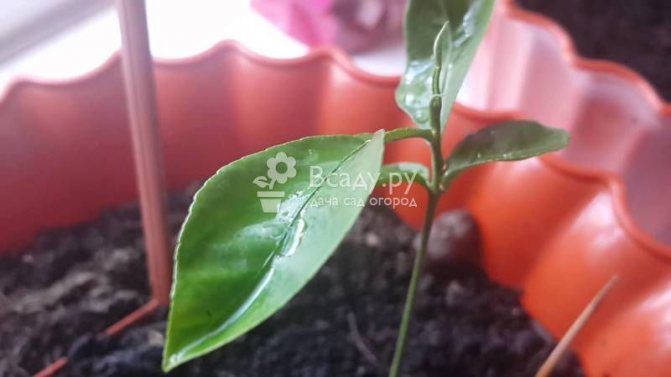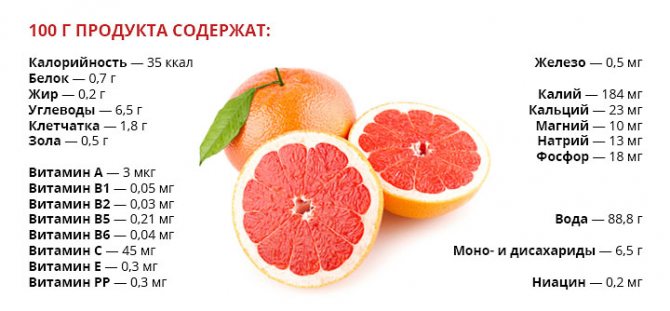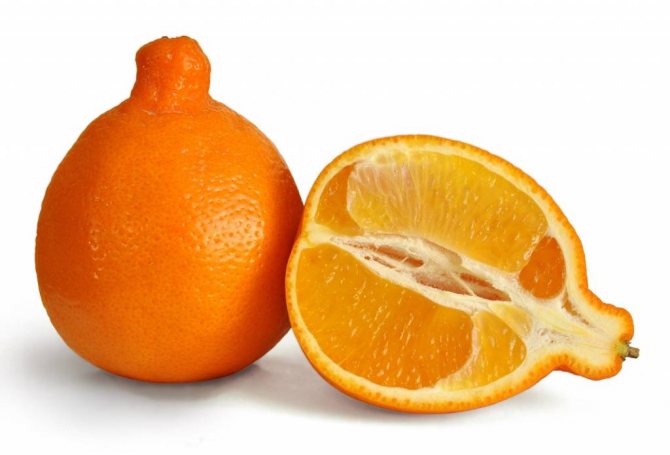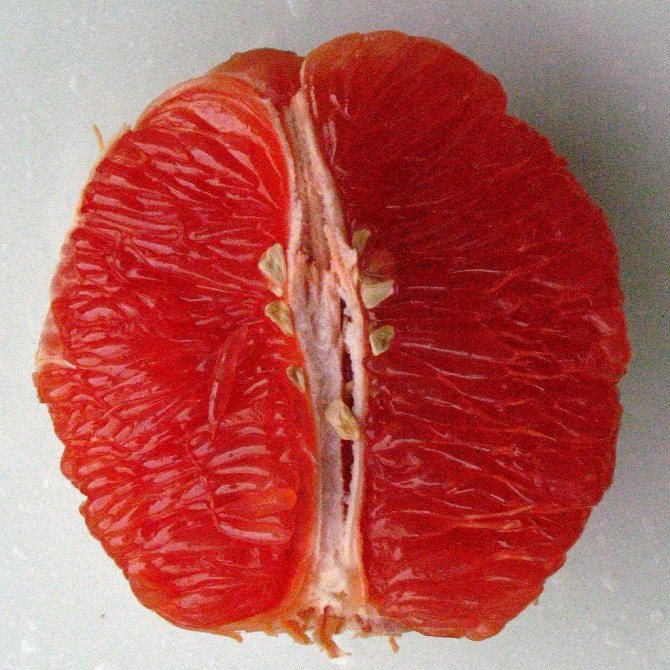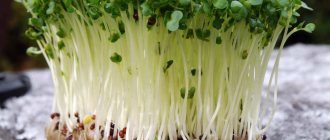Horticulture »Citrus» Grapefruit
0
834
Article rating
Grapefruit grows at home only if the rules of care and cultivation are followed. The culture is rarely planted in the garden: the tree grows only in tropical climates. To grow grapefruit at home, you should choose the right variety: not all of them bear fruit.
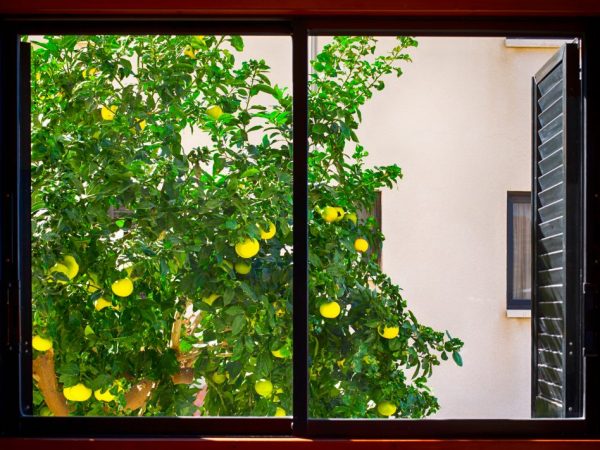
Growing grapefruit at home
Where to start when growing grapefruit at home?
So, in order to grow a grapefruit from a seed at home, we need a flowerpot for a plant, soil, a drainage agent (polystyrene, pebbles), fertilizer for citrus fruits or ordinary humus and, of course, a grapefruit seed. The largest and most beautiful bones are chosen for sowing.
Before planting, drainage is laid out on the bottom of the pot, and then it is covered with soil mixture. The soil in this case should be sour, and for its preparation you need to take such ingredients. This is sod / deciduous land, humus, river sand and peat in a ratio of 2: 1: 1: 1: 1. The bone is immersed in the ground to a shallow depth, sprayed with water from a spray bottle and waiting for the first shoots. Do not worry when the bone "does not wake up" for a long time, because it can lie in the ground for up to four weeks. In winter, the plant is rarely watered, but the earth lump is not allowed to completely dry out, and in the summer, watering is carried out every day, avoiding waterlogging and stagnation of water. Grapefruit is a very thermophilic and light-loving plant that quickly adapts to indoor conditions.
A young plant is transplanted every year, and then (starting from the age of five) a tree is transplanted every three years, choosing a convenient pot with good drainage.
Grapefruit - an exotic citrus with beneficial properties
There is an opinion that no one was specifically engaged in the cultivation of this citrus. Breeders believe that it appeared spontaneously, as a result of crossing a sweet orange and a pompelmus. Grapefruit grows on an evergreen tree with large, beautiful leaves. With proper indoor cultivation, the plant blooms and bears fruit regularly.
The flowers of this plant exude a strong exotic scent. They are located in inflorescences of 15-20 pieces. Each leaf of the plant lives for 1.5-3 years. For home cultivation, I use the Sheddock and Duncan varieties.
I decided to plant grapefruit at home not only because of the aesthetic beauty of this plant. Its fruits have many beneficial properties that have a beneficial effect on the body. The juice of this citrus stimulates the immune system and the production of gastric juices. The systematic use of grapefruit is recommended to strengthen the nervous system.
Output
Grapefruit (pompelmus) is a healthy fruit with a specific taste, recommended to almost everyone. It prevents diseases, helps in treatment. It is especially recommended by nutritionists, as it relieves excess weight and prevents excess weight gain. Often a small sheddock is used in cosmetology.
Since some harm is possible, it is first necessary to clarify whether the product conflicts with the prescribed drug program, whether it is tolerated by the body. Pompelmus should be eaten in reasonable amounts so as not to harm yourself.
The specifics of growing
It is important to understand that tropical plants love a humid environment without critically low temperatures.In nature, grapefruit can reach 7-8 meters. I try to create all the conditions for the growth of a tree in a home, given the tallness of the culture: I plant it in a large pot, prepare free space, supports and garters.
Each ripe citrus contains up to 10 seeds, ready to grow. When preparing, it is worth choosing large bones with the correct shape. For planting in an apartment, I use several seeds at once, since not all of them are viable.
In order for the grapefruit to bloom and bear fruit when planting a plant, I observe the following rules:
- in pots I use a mixture of peat, sand and flower soil;
- I bury the bones in the ground by 2 cm, cover with polyethylene and place the pot in a bright, warm place;
- it is important to monitor the humidity, and after blooming the first pair of leaves, you can remove the plastic wrap;
- I transplant the grapefruit into a large pot when its height reaches 10-13 cm.
In the following steps, I add flower soil to the pots, sometimes using the top of the forest soil instead. Not rush, and not moss, but humus under them.
Care features
The grapefruit tree is a capricious plant and requires constant attention. Young shoots feel good on the windowsill, but for the plant to bear fruit, the location must be warm and light. In the summer, the trees can be taken out into the garden or on the terrace, and in winter, the temperature must not be allowed to drop below five degrees Celsius.
During the period of increased growth, I feed grapefruit trees with ready-made mineral complexes for citrus fruits 1-2 times a month. An important condition for the normal development of culture is moderate air humidity. If the room is very warm and dry, the tree may shed its foliage. The plant also suffers from excessive moisture, can get sick, and waterlogging of the soil will lead to rotting of the root system and death.
I replant young grapefruit trees annually as they grow. But already from the age of five, it is enough to do this once every three years. It is important not to destroy the earthen ball during transplantation, so as not to damage the rhizome. At the end of the procedure, I moisturize and compact the soil around the plant.
With proper care, the grapefruit tree will bloom and bear fruit regularly. This exotic plant will not only decorate your home greenhouse, but also provide households with delicious and healthy citrus fruits.
Irina Vasilieva, gardener
Instructions
Not everyone knows that grapefruits are even tougher than lemons! Large bones
grapefruit can be immediately placed in the ground at a shallow depth - but it should be remembered that the grains sometimes "sit" in the ground for a long time, even for a month.
Young grapefruits love loose and acidic soil rich in minerals. The plant needs rare watering. In this case, you should not bring the state of the soil in the pot to drought. You can lightly spray the tree every day with warm water from a spray bottle.
A grapefruit growing from a seed needs a lot of light and warmth. It should be fed with citrus fertilizer twice a month. The grapefruit grown from the seed, while it is young, needs to be transplanted into a larger container every year. After the grapefruit reaches the age of five to six years, this can be done every two to three years. Suitable for transplanting "garden" soil with humus or ready-made earth for citrus fruits from the store.
While the tree is small, it is comfortable for him on any windowsill. However, the grapefruit grows quite tall (on average, two meters) and spreading. An adult plant will be more comfortable in a bright office space, on a loggia or in a winter garden.
When favorable conditions are created, the grapefruit successfully blooms and bears fruit. It grows many large glossy leaves. Large flowers, which are white with a pinkish tint, bloom towards the end of summer, when the heat subsides.Large fruits with thick skin, strong aroma and bittersweet taste usually ripen by November.
note
Experts believe that grapefruit is a unique hybrid of orange and pamelo, which naturally arose as a result of an unexpected natural crossing.
Helpful advice
The dangers of growing grapefruit from seed at home are pests (citrus red mite, scale insects, citrus whitefly), spots and leaves may fall off. Insects must be fought with special means. More frequent ventilation of the room will relieve stains. Sprouted leaves indicate excess or lack of moisture.
Related article
Sources:
- "Growing vegetables, fruits, herbs and berries"
- grapefruit cultivation
Do you want to grow beautiful at home mineral
? Easily! In nature
mineral
s are often formed in water
mineral
isolated solutions. The same principle can be used at home. All you need to do is choose which one
mineral
would you like to. For example, see how easy it is to grow delicious blue at home.
mineral
chalcanthite.
You will need
- 100 grams of copper sulfate, jar, 100-150 ml of water, thread, pencil.
Instructions
Buy two sachets of copper sulfate from any garden supply store. Usually sold in 50 grams, therefore, you need to purchase 100 grams of vitriol to grow a crystal. Take a small jar and pour water into it. The amount of water should not be large, no more than 150 and not me 100 ml. Heat the water.
Tie the vitriol grains to a thread, and fasten the thread to a pencil. Thus, it will lie on the neck of the jar and keep the grain in water. Choose only coarse grains.
Pour the rest of the sachets into a jar. Remember, the water must be hot. Stir well to create a supersaturated solution. The solution should be dark blue. Subsequently, a precipitate will form at the bottom of the jar until the solution becomes saturated. When the solution gets rid of the supersaturation, the color will change to. If the solution is not oversaturated, there are two solutions. Either buy another bag of copper sulfate or wait for the water to disappear. In this case, it will take several days.
Cool the solution. When the temperature reaches room values, lower the previously harvested grains on a thread into the solution. As soon as the precipitation begins, the seed will begin. Mineral for about 4 days.
Once a day, the crystal must be pulled out and the solution heated. Also stir the sediment, cool the solution again and lower the vitriol grain again. For smooth edges of the future crystal, the growths from the thread can be cleaned off or dissolved.
Related Videos
note
Attention! Copper sulfate is poison!
If you want to plant on your site, you can purchase a seedling from a nursery or simply dig it up in the nearby forest. But it is much more interesting to grow a tree yourself, from a seed. It is quite unpretentious, grows quickly and does not require special care. And if you wish, you can plant a whole pine forest.
You will need
- - Pine cones;
- - a box with holes;
- - land and peat;
- - potassium permanganate;
- - fertilizers.
Instructions
Prepare a plastic or wooden box. There must be holes in it so that excess water can drain. Fill the container with soil mixed with peat. The latter will prevent fungal infections of seedlings. Pour seeds on top, and then slightly loosen the soil.
Place the box in a place where the sun's rays will illuminate it. Best of all - on the windowsill: there is a lot of light, and the pine loves it. Moisten the soil. When sprouts appear, water them every day. But do not overdo it so that the seedlings are not hit by late blight.
To protect against fungus, you can water with a weak solution of potassium permanganate, but then growth will slow down. Use ready-made fertilizers for plant fertilization.After 5 months, the pines will get stronger, their trunks will become stiff. Leave them to grow in a box over the winter, but do not create a greenhouse environment.
In the spring, transplant the seedlings into the ground. Do this carefully, carefully separating the thin roots when removing from the drawer. Plant 12-15 cm apart, shallow. Cover the top with sawdust so that weeds do not interfere with development. Water and weed periodically, feed young trees. After 3 years, they will grow up to 60 cm in height. Now they can be transplanted to a permanent place. It is best to plant with an earthen clod. That's all, now the pine trees you have grown will delight you for many years.
Adding a fragrant circle of juicy lemon to tea, many probably at least once wondered: "How to grow a lemon from a seed at home?" Some, despite their curiosity, do not dare to start growing this exotic citrus plant. Others, having tried to do it once and failed, forever throw the thought out of their minds. In fact, growing lemon at home is not difficult. To do this, you should be patient and follow some simple rules.
You will need
- - fluorescent lamps or agro-lamps; - a plate of water; - seeds of lemons; - small pots with holes in the bottom; - drainage; - the soil; - vermicompost; - large pot
Instructions
Before you start growing lemon, assess the conditions in which this long but incredibly interesting process will take place. Lemon is a light-loving plant. Its proper development, flowering and fruiting can occur only in a place where the lemon will be exposed to sunlight for at least several hours a day. If your windows face north, equip them with additional lighting.
In addition to lighting, when growing lemon from a stone at home, you should also monitor the humidity of the air. It should not be less than 40%, otherwise the plant will die at the first stage of development, without giving you fragrant foliage and juicy fruits. In order to provide the lemon with sufficient air humidity, place a bowl of water on the windowsill.
In order to successfully grow a lemon from a stone at home, choose the brightest, smoothest and most appetizing fruit in a store or on the market. Remove the bones from it, take the largest of them and immediately start planting.
For sowing lemon, small pots with holes in the bottom are best. Fill the bottom with drainage. Then fill the pot with loose soil made by mixing garden soil, peat, and coarse sand. Put lemon seeds into the ground to a depth of 2 cm. Plant several seeds at once. This is necessary in order to make it easier for you to choose the strongest and healthiest plants in the future. Within a month after planting, you will be able to notice the emergence of seedlings.
After waiting for the seedlings to grow, after about 3-5 months, carefully transplant them into a large flower pot, without disturbing the earthen lump formed during the development of the root system. In order to accelerate the growth of lemon, add a little vermicompost to the soil.
Normal development of a lemon from a seed can only occur when the plant has side branches in addition to the stem. In order to induce their appearance, cut off the top of the lemon with the onset of spring, and leave some of the buds on it intact. In the future, shoots of the first order will appear from them. When they grow up, remove them, leaving the buds for second-order shoots. Repeat this procedure until the fourth order shoots appear, which will bear fruit.This entire process, from planting seeds to the formation of the first fruits, can take from 4 to 10 years, so be patient and wait for the lemons to appear, which taste in no way inferior to citrus grown in hot countries.
Grapefruit gained widespread popularity in the 19th century, although these evergreen citrus trees were first discovered on the island of Barbados in 1750. The large-fruited fruit went down in history immediately as a cultural one, since nothing of the kind was found in the wild. Scientists have come to the conclusion that its appearance was facilitated by the natural process of hybridization between pomelo and. How the grapefruit grows can be guessed from its name, because in English it means "grape fruit".
Cooking recipes
The pulp of "paradise citrus" is usually mixed in salads with chicken, nuts (pistachios, etc.), apples and eggs. In fruit salads, it goes well with oranges, pears, black grapes, tangerines and apples. If you want something a little more exotic, you can add figs, dates, walnut kernels or pistachios.
Grapefruit and chicken salad (2 servings)
- Cut off the fillet with the skin from the chicken carcass (approx. 450 g), rinse and dry. Fry 1 tbsp. l. unpeeled pistachios in a frying pan without fat, remove the kernels.
- Heat 1-2 tbsp. l. olive oil. Fry the chicken fillet over medium heat on each side for 6-7 minutes. Sprinkle with pepper and salt. Peel two pink grapefruits and select the pulp. Squeeze out the juice from what is left.
- For the vinaigrette sauce, take 1 chilli pod, cut in half lengthwise, remove the seeds, wash and chop with a knife. Mix 6 tbsp. l. juice, salt, a pinch of sugar and pepper. Add 4 tbsp. l. olive oil. Stir in chili. Mix Greek yogurt (100 g) with lemon juice and season with salt.
- Peel and rinse four green onion feathers and cut into small rings. Rinse four sprigs of mint and parsley, dry, tear off the leaves from them. Chop the herbs and pistachios coarsely.
- Combine grapefruit pieces, green onions, herbs and vinaigrette. Arrange on plates. Take the meat from the frying pan, cut into thin slices, and lay beautifully on top. Pour yogurt over fillets, sprinkle with pistachios.
Tip: If Greek yogurt is not available, you can use thick sour cream.
Confiture (about 2 kg)
- Wash 900 g cherries and drain with water. Then remove the cuttings, remove the seeds and chop. Remove the peel from one grapefruit (about 300 g) with a knife so as to completely remove the white skin. Cut the pulp and cut into small pieces. In general, you should get about a kilogram of pulp (cherry + grapefruit).
- Mix the fruit mass with 1 kg of gelling sugar, bring to a boil and cook for about 6 minutes with a bubbling boil. Then pour in 2 tbsp. l. cherry liqueur. Remove foam. Fill clean jars with hot confiture, close them with lids, turn over and allow to cool.
Grapefruit tree
It is very difficult for anyone who has bought grapefruits more than once to imagine a bunch of grapes of at least 2-3 fruits reaching a weight of 500 g. and twice as much.
The grapefruit tree is the tallest of all citrus varieties. It reaches an average height of 5-7 meters. Some varieties can even grow up to 12 meters. The wood is quite elastic and durable, with a smooth gray-brown bark. Therefore, the branches are able to keep the number of weighty fruits.
Large oval leaves of grapefruit reach 15-17 cm in length. They form a dense spreading crown, which is in the form of an ellipse or a ball. During the flowering period, you can observe an amazing picture that will take your breath away. The tree is covered with large, up to 5 cm in diameter, white flowers with a fragrant aroma. This advantage allowed the grapefruit to be only an ornamental plant for a long time.
As a result of modern breeding, up to 20 grapefruit varieties have been created, which differ in ripening time, color of peel and pulp. The latter can be very light (almost white or yellowish), pink or bright red. The redder the flesh of the grapefruit, the sweeter it is.
Application and contraindications
Sweets are eaten in the same way as grapefruit - cut in half or spoon to scoop out the delicious pulp. Peeled from the skin and partitions, it is often added to salads and desserts. To taste, pomelite goes well not only with other fruits, but also with seafood, poultry and vegetables.
As for contraindications, then sweets
they are very similar to grapefruit. Those who have problems with the gastrointestinal tract, first of all, increased acidity of gastric juice, gastritis, colitis, enteritis, and inflammatory bowel diseases should refuse the use of these citrus fruits. Also, it should not be eaten by those who suffer from hepatitis, cholecystitis and acute nephritis.
In what conditions does grapefruit grow
Grapefruit is a thermophilic plant, so it prefers a subtropical climate, like all of its relatives. In our country, this is the Black Sea coast, in America, grapefruit is cultivated in Florida and Texas. Naturally, large plantations in his homeland - in India, the supply of grapefruit to European countries is puzzled by Cyprus, Israel, Brazil, China.
The plant is demanding on sunlight and soil fertility. It is necessary to monitor the sufficient content of organic matter and mineral salts. Subject to all the necessary conditions, the grapefruit begins to bear fruit for 4-5 years. The fruits grow and ripen for a long time: from 9 to 12 months and are not removed at the same time. In regions where ripening begins in September, the grapefruit is harvested until April. In some areas, the crop ripens in February. So, on the island of Juventud (Cuba), a real celebration is organized in February in honor of the ripening of grapefruit, which lasts for several days and ends with a feast.
Grapefruit (Citrus paradise) is a perennial evergreen citrus plant belonging to the Rutaceae family. The birthplace of culture is Southeast Asia. Under natural conditions, it grows in the United States, Mexico, Argentina, the Middle East and the Caribbean, reaching a height of 5 to 6 m.Some varieties are real giants with a height of about 15 m.
How a grapefruit tree grows indoors (with photo)
The "fashionable" culture became in the last century, when the dietary "grapefruit diet" became popular. Since then, its cultivation began in houses and apartments by amateur gardeners.
Indoors it grows up to 1.5-2 m. The leaves are leathery, shiny, rich green, wider than that of an orange, 10-20 cm long, slightly pubescent below, on long petioles.
Can bloom and bear fruit in the room. It blooms in spring, flowers are large, white with a pinkish tinge and strong aroma, single or collected in a cluster.
The fruits are large (300-400 g), their peel is quite thick (from 1 to 1.2 cm). They are distinguished by the presence of tasty and juicy pulp. The fruits ripen in late October - November.
It is best to grow young specimens in a room on the windowsills. Adult plants feel most comfortable in greenhouses, conservatories or office buildings.
What a blooming and fruiting grapefruit looks like is shown by the photos below - check them out to get a visual idea of this "green pet":
Description of culture
The ancestor of grapefruit is India and Central America. The grapefruit tree is a hybrid of an orange and a pomelo. The fruits of the culture are considered dietary, they are often used to treat diseases.
The plant is new, found several hundred years ago. For a comfortable development, a tree needs a lot of light, the right climate and a high temperature regime.
History
The name of the culture comes from 2 English words: "grape" (lane - "grapes") and "fruit" (lane - "fruit"). Scientists call the culture the aciniform pompelmus.
The fruit began to spread actively in the twentieth century. The USA is the largest producer of this crop, more than 85% of the fruits are grown in this country.
Description of fruit and tree
Features of the tree:
- the crown is dense, often rounded;
- it stretches in height by 8 m in open areas, and by 2 m - at home;
- large leaves with a blunt end, green in color;
- blooms with large flowers with a bright scent;
Features of the fruit:
- rounded shape;
- fruit diameter - up to 13 cm;
- yellow;
- thick peel - up to 1.5 cm;
- elastic and juicy flesh, often of a light shade;
- sweet and sour taste with bitterness;
- large seeds.
Flowering has 2-3 periods. Grapefruit is rich in vitamins and useful nutrients, not inferior even to lemon (up to 50 mg of vitamin C per 100 g of fruit). Red-fleshed citruses are high in vitamin A.
The growing fruit contains proteins such as arginine, alanine, lysine, serine. The peel contains potassium, iron, phosphorus.
Freshly squeezed juice is used to whet the appetite or for high blood pressure.
How to grow grapefruit from seed and cuttings at home
The simplest and most common way to breed most grapefruit varieties is from seed. To do this, you need to select fully ripe fruits and extract seeds from the pulp that have the correct shape. To get 100% result, it is recommended to plant several seeds at once, since not all of them may be viable.
There is no need to pre-dry the seeds: after removing them from the pulp, they can be immediately placed in the soil, poured into small flowerpots (there is a separate container for each bone). The substrate in this case will be a mixture of flower soil and peat, taken in a 1: 1 ratio. It is also recommended to add some river sand.
To grow a grapefruit from a seed, the seed should be deepened by 2 cm and poured with a little water at room temperature. Then the flowerpot must be covered with a transparent plastic bag and removed to a warm and well-lit room.
You need to open the mini-greenhouse for airing every day, and water it as the top layer of the soil dries out. Seedlings, subject to these rules, should appear on the 14-21st day.
As soon as the first pair of leaves bloom, the polyethylene is removed, making sure that the direct rays of the sun do not fall on the plant. But the room should still be warm and light.
Growing an indoor grapefruit at home from a stone implies transplanting a tree into a large container, as soon as its height reaches from 10 to 13 cm.When performing the procedure, you need to ensure that the roots that have not yet matured remain unharmed.
A young grapefruit grown from a seed at home is shown in the photo - appreciate the beauty of the plant, which is obtained by following the recommendations described above:
Seedless varieties are propagated by cuttings. The procedure is recommended in March - April or June - July. You need to cut cuttings from 8 to 10 cm long, which have 6 leaves. Before growing grapefruit from cuttings at home, the propagation material should be placed in moistened river sand and covered with polyethylene on top. In order for rooting to occur as quickly as possible, it is recommended to maintain a temperature regime in the mini-greenhouse in the range from +23 to +25 ̊С. After the roots appear (this often takes about 2-3 weeks), you can plant the cuttings in a soil mixture of leafy and soddy soil, humus and sand (2: 1: 1: 0.5), laying a drainage layer on the bottom of the flowerpot.Lighting, location, watering the seedling need the same as if you decided to grow a grapefruit from a seed.
Reproduction by vaccination is possible. Can be grafted onto home-grown grapefruit seedlings. Fruiting occurs in the 4th-5th year.
This procedure can be started only in the spring - until the beginning of May. At this time, the most intensive movement of juices in the plant and growth processes are observed. Slices on the scion and rootstock should be made with a sharp tool, each of them carried out in one even and quick movement. The cambial layers of the scion and rootstock are connected with maximum accuracy, and for this the diameter of the sections must be approximately the same.
The junction is tightly pressed, wrapped with a soft insulating tape.
When asked how to grow a strong and healthy grapefruit, experienced gardeners answer: provide the scion with high humidity. To do this, it is recommended to wrap a bag under the junction, wind a moistened cotton swab or a piece of sphagnum moss next to the graft, fix the bag so that the scion is located inside it. Then the chances of a successful vaccination will increase significantly.
Storage
Fresh, fully ripe fruits are not stored for a long time. The more ripe the fruit, the faster it will deteriorate. In order to extend the shelf life of grapefruit, it is stored in the refrigerator. The maximum storage period is no more than 10 days. After that, the citrus dries up, loses its taste and aroma.
The duration of storage of fruits in maturation at a temperature of + 7-12 ° C and an air humidity of 85-95% reaches several months. For this, the fruits are removed a little unripe. As they ripen, the intensity of their color increases, and when it reaches its maximum, it begins to decrease. During the entire storage period, fruits retain their taste, aroma and valuable properties.
How to plant a grapefruit in a new pot
Plants up to 5-6 years old are transplanted annually, then - once every 3-4 years. This procedure is necessary if the root system fully assimilates the soil in the pot and begins to protrude from the holes at the bottom of the flowerpot.
An adult plant needs to be poured with fresh substrate annually. For transplanting, you need to use loose fertile soil with a neutral acidity index. Good for indoor grapefruit tree and ready-made substrate "Lemon". You can prepare the planting soil yourself from leafy and sod land, humus and sand (2: 1: 1: 0.5). It is important that it is saturated with all the necessary trace elements (boron, cobalt, manganese, zinc, etc.) and macronutrients (nitrogen, potassium, calcium, copper, magnesium, sulfur, phosphorus). It is also recommended to put a couple of nails in the substrate, since subtropical and tropical plants require iron in the soil. Under the influence of acidic secretions from the roots, macronutrients will be released from the nails, absorbed by the plant.
Before planting a grapefruit in a new flowerpot, a drainage 5 to 8 cm thick must be laid on the bottom of the container so that excess water does not stagnate in the root system during watering and does not cause it to rot. This layer can consist of fine gravel, foam, expanded clay.
For transplanting, a transshipment method is used, in which the soil on the roots is not disturbed, but transferred to a new pot. The void is filled with fresh substrate. This method provides minimal trauma to the plant root system.
Travel conditions for grapefruit: watering, fertilizing and pruning
Grapefruit needs a bright, sunny window. In summer, before the onset of frost, the plant can be kept in the garden, on the balcony, on the open terrace. In winter - in a bright room. The total duration of daylight hours when growing indoor grapefruit should be between 10 and 12 hours.
It is better to place the flowerpot on the east or west windowsill. If the pot is on the south window, then you need to take care of shading it at noon. On the windowsill facing the north side, you will have to use a phytolamp to organize additional lighting. In autumn and winter, additional lighting will be needed in any case, regardless of the location of the container with the plant.
In the spring-summer period, the optimal temperature regime for the culture is within + 20 ... + 27 ° С, in winter, coolness is needed - from +4 to +8 ° С. We grow grapefruit in such conditions at home - and it will delight you with abundant flowering and fruiting.
Optimum indicators of air humidity for the culture are average: from 50 to 60%. To increase it in hot weather, it is recommended to spray the plant every day with a spray bottle using soft water at room temperature. A warm tree shower is also acceptable.
Watering is needed regularly, in summer it is plentiful, but water stagnation should not be allowed, otherwise the soil will swamp, and the roots will rot. Due to the drying out of the substrate, the culture may also die.
Home care for grapefruit provides: if there is a strong heat outside the window, watering should be daily, if the temperature is moderate, as the top layer of the soil dries out. In winter, the frequency of irrigation is significantly reduced - due to the coolness, the soil will dry out more slowly.
For humidification, take river or distilled water at room temperature. If it is not possible to obtain such a liquid, then you can use ordinary tap water, but it must first be filtered or defended for a couple of days.
Growing a grapefruit tree at home involves regularly applying fertilizers to the substrate. Plants are fed from April to September, twice a month, with complex fertilizers suitable for citrus crops. If the tree is kept in a room with a low temperature during the winter, then feeding completely stops. If the temperature is higher than the recommended one, fertilizing should be applied, but once every 30 days.
Look at the photo depicting a grapefruit grown at home, subject to the described conditions of detention and care rules:
This is an important aspect of tree care. It often reacts positively to the procedure - 2 new ones grow in the place of the cut off shoot. It is immediately recommended to decide on exactly what height the tree needs to be obtained. Further, it is necessary to leave no more than 2 or 3 bearing branches, above which the crown should be placed. Maintain the neat appearance of the plant by pruning it annually. How the crown of a grapefruit grows, is formed, study the photos below - they clearly demonstrate how to trim:


